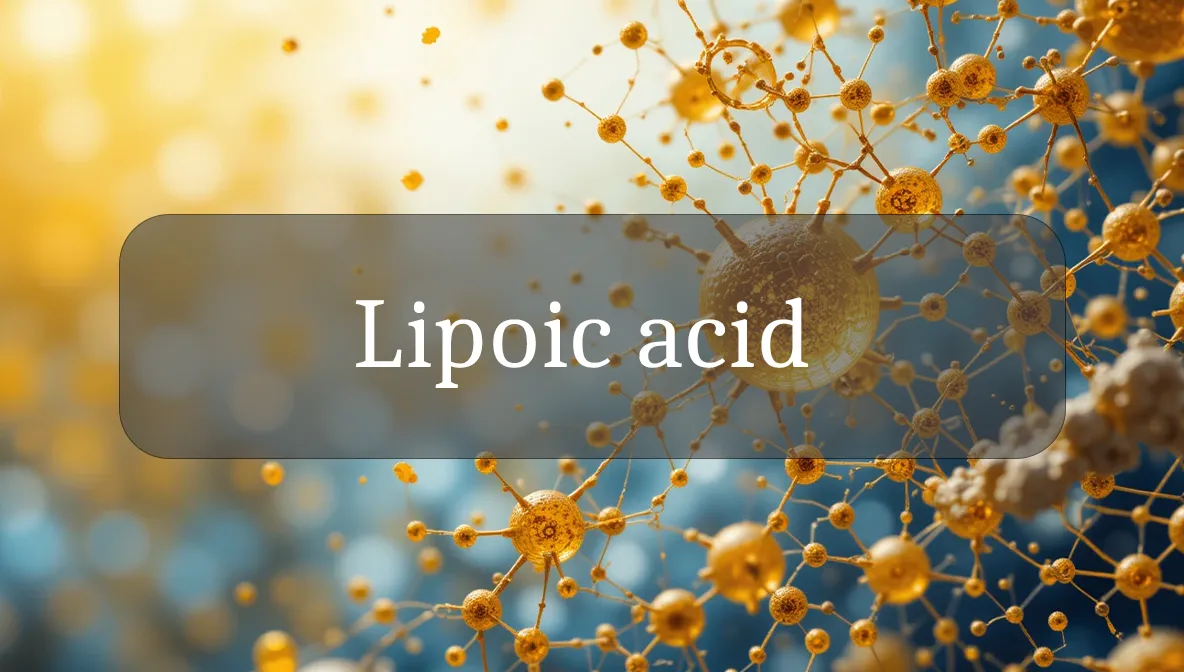Antioxidant Powerhouse for Energy and Cell Protection
Lipoic acid, often called alpha-lipoic acid (ALA), is like a superhero molecule in your body, fighting damage, boosting energy, and supporting overall wellness. This unique compound acts as both an antioxidant and a coenzyme, making it a favorite for health-conscious folks. Let’s explore what lipoic acid is, how it benefits your health, and how to incorporate it into your daily routine.
Chemical Identity and Type
Lipoic acid is a sulfur-containing organic compound, classified as a coenzyme and antioxidant. It’s a small molecule that’s both fat- and water-soluble, allowing it to work in various parts of your cells, from membranes to mitochondria (your cells’ energy factories). Your body produces small amounts of lipoic acid, but you can also get it from food or supplements, where it’s often provided as alpha-lipoic acid.
Biological Role and Benefits
Lipoic acid is a versatile nutrient with benefits that keep your body thriving:
- Antioxidant Protection: It neutralizes harmful free radicals, protecting cells from damage that can lead to aging or chronic diseases, and regenerates other antioxidants like vitamin C and E.
- Energy Production: As a coenzyme, lipoic acid helps convert carbs into energy in mitochondria, boosting stamina and reducing fatigue.
- Blood Sugar Support: It improves insulin sensitivity and glucose uptake, helping stabilize blood sugar levels, which is especially beneficial for those with diabetes or prediabetes.
- Nerve Health: Lipoic acid may reduce nerve pain or tingling (neuropathy), particularly in diabetic neuropathy, by protecting nerve cells.
- Heart and Brain Health: Its antioxidant and anti-inflammatory effects support healthy blood vessels and brain function, potentially lowering the risk of heart disease and cognitive decline.
By shielding cells and fueling energy, lipoic acid promotes vitality, focus, and long-term wellness.
Dietary or Natural Sources
Your body makes small amounts of lipoic acid, but dietary sources and supplements can boost levels:
- Organ Meats: Liver and kidney (e.g., 3 oz beef liver: trace amounts of ALA).
- Red Meat: Beef and pork contain small amounts.
- Vegetables: Spinach, broccoli, and Brussels sprouts (1 cup cooked spinach: trace ALA).
- Yeast: Brewer’s yeast has minor amounts.
- Supplements: Alpha-lipoic acid supplements (100–600 mg daily) are the most common way to increase intake, often used for blood sugar or nerve support.
Since food sources provide only trace amounts, supplements are typically needed for therapeutic benefits.
Signs of Imbalance or Dysfunction
Lipoic acid isn’t an essential nutrient, so “deficiency” is rare, but low levels may contribute to:
- Fatigue or Low Energy: Reduced mitochondrial function from insufficient ALA.
- Increased Oxidative Stress: More cell damage, leading to signs of aging or chronic disease risk.
- Nerve Discomfort: Tingling, burning, or numbness, especially in those with diabetes or nerve issues.
- Poor Blood Sugar Control: Spikes or crashes in energy, particularly in insulin-resistant individuals.
Excess lipoic acid is uncommon but may cause:
- Mild Digestive Upset: Nausea, stomach pain, or diarrhea at high doses (above 600 mg).
- Skin Rash: Rare reactions to supplements.
If you notice nerve pain, fatigue, or blood sugar issues, consult a doctor to assess underlying causes.
Supporting Optimal Levels or Function
To maximize lipoic acid’s benefits:
- Consider Supplements: Take 100–600 mg ALA daily (with food to reduce stomach upset) for antioxidant or blood sugar support. Start low (100–200 mg) to assess tolerance. Effects may take 4–8 weeks.
- Eat Nutrient-Rich Foods: Include ALA-containing foods (spinach, liver) and antioxidants (berries, nuts) to support ALA’s cell-protecting role.
- Manage Blood Sugar: Pair ALA with a low-glycemic diet (whole grains, veggies) to enhance its glucose-regulating effects.
- Stay Active: Exercise boosts mitochondrial health, amplifying ALA’s energy benefits.
- Support Overall Nutrition: Ensure adequate B vitamins (e.g., B1 in whole grains) and magnesium (nuts, greens), which work with ALA in metabolism.
Safety, Interactions, and Precautions
Lipoic acid is generally safe, but keep these points in mind:
- Side Effects: High doses (above 600 mg) may cause nausea, heartburn, or rash. Rarely, low blood sugar can occur, especially in diabetics.
- Medication Interactions: ALA may enhance the effects of diabetes drugs (e.g., insulin, metformin), risking low blood sugar. Monitor glucose levels and consult a doctor. It may also interact with thyroid meds or chemotherapy.
- Medical Conditions: If you have diabetes, thyroid issues, or B1 deficiency (e.g., from heavy alcohol use), use ALA cautiously and under medical supervision.
- Allergies: Rare allergic reactions (itching, swelling) can occur with supplements. Choose high-quality, tested brands.
- Children/Pregnancy: Avoid ALA supplements unless prescribed, as safety data is limited.
Fun Fact
Did you know lipoic acid is nicknamed the “universal antioxidant”? Its ability to work in both watery and fatty parts of cells makes it one of the most versatile cell protectors in your body, unlike most antioxidants that stick to one environment!
Citations
- National Institutes of Health (NIH): Alpha-Lipoic Acid Overview.
- Mayo Clinic: Alpha-Lipoic Acid for Neuropathy and Diabetes.
- Cleveland Clinic: Antioxidants and Metabolic Health.
- Journal of Clinical Biochemistry and Nutrition: Alpha-Lipoic Acid and Oxidative Stress (2020).
- Harvard T.H. Chan School of Public Health: The Nutrition Source – Antioxidants.

